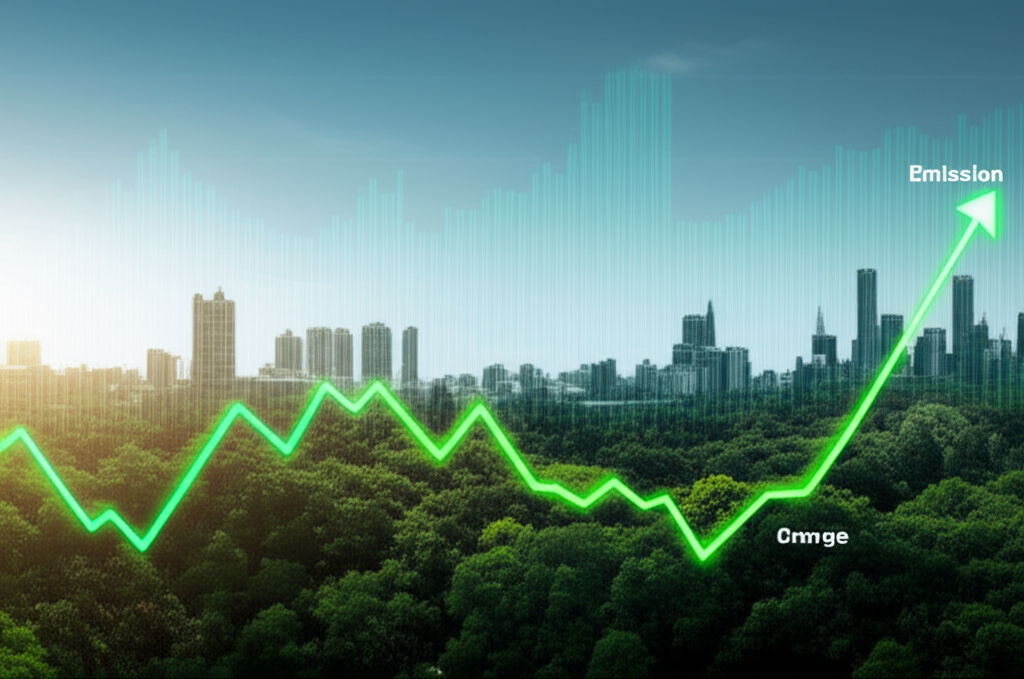Carbon Pricing: Climate Action Tool
Emily Willis

Photo: Carbon Pricing: Climate Action Tool
Carbon Pricing: A Powerful Tool for Climate Action
Climate change is undeniably one of the most pressing challenges of our time. From melting glaciers and rising sea levels to extreme weather events, its impacts are felt across the globe, threatening ecosystems, economies, and human well-being. Addressing this complex issue requires a multi-faceted approach, and among the most discussed and potentially impactful solutions is carbon pricing. This economic mechanism aims to make polluters pay for their carbon emissions, thereby incentivizing a shift towards a cleaner, more sustainable future.
This article will delve into the world of carbon pricing, exploring its fundamental concepts, how it operates in practice, its myriad benefits, and the challenges that must be addressed for its widespread and equitable implementation.
What Exactly is Carbon Pricing?
At its core, carbon pricing is an instrument designed to capture the "external costs" of greenhouse gas (GHG) emissions. These external costs are the societal burdens that result from pollution, such as damage to crops, healthcare expenses from heatwaves, and property loss due to rising sea levels, which are typically borne by the public rather than the polluters themselves. By assigning a monetary value to carbon dioxide (CO2) and other GHG emissions, carbon pricing mechanisms aim to shift this burden back to those responsible, encouraging them to reduce their carbon footprint.
Instead of governments dictating specific technologies or methods for emissions reduction, carbon pricing provides an economic signal. This signal allows businesses and individuals to decide for themselves whether to transform their activities to lower emissions or continue emitting and pay the associated price. This market-based approach seeks to achieve environmental goals in the most flexible and cost-effective way possible.
There are two primary forms of carbon pricing:
- Carbon Tax: This is a direct tax on greenhouse gas emissions, or more commonly, on the carbon content of fossil fuels. It sets a fixed price per ton of CO2 equivalent (tCO2e). The emission reduction outcome is not pre-defined, but the price is certain.
- Cap-and-Trade (Emissions Trading Systems - ETS): This system sets a "cap" or limit on the total amount of greenhouse gas emissions allowed within a specific jurisdiction or sector. Companies are then issued a set number of emission "allowances" or permits. Those that reduce their emissions below their allocated limit can sell their excess allowances to companies that exceed their limits. This trading creates a market price for carbon emissions, and the overall cap ensures that total emissions decline over time.
Why Carbon Pricing? The Economic Logic Behind Climate Action
The rationale behind carbon pricing is rooted in fundamental economic principles. The emission of greenhouse gases is a classic example of a "negative externality" – a cost imposed on a third party who is not directly involved in the economic activity that produces the pollution. Without a mechanism to account for these costs, there's no inherent financial incentive for emitters to reduce their pollution.
Carbon pricing addresses this market failure by internalizing these external costs. By making pollution costly, it creates a powerful financial incentive for individuals and businesses to:
- Reduce Emissions: When emitting carbon becomes more expensive, companies and consumers are incentivized to find ways to use less fossil fuel-based energy and adopt cleaner alternatives.
- Innovate and Invest in Clean Technologies: A price on carbon encourages research, development, and investment in low-carbon technologies and sustainable practices. This can lead to the creation of new green jobs and foster economic growth in sustainable sectors.
- Promote Energy Efficiency: Businesses and households will seek more energy-efficient practices and technologies to lower their carbon costs, leading to reduced energy consumption.
- Adhere to the "Polluter Pays" Principle: This principle asserts that those who cause pollution should bear the costs of managing it to prevent damage to human health or the environment. Carbon pricing directly embodies this principle.
How Carbon Pricing Works in Practice: Mechanisms and Examples
Understanding the two main types of carbon pricing is crucial to appreciating their distinct applications and impacts.
Carbon Tax
A carbon tax is straightforward: a direct fee imposed on each ton of CO2 equivalent emitted. This provides a clear and predictable price signal for businesses and consumers.
Examples:
- British Columbia, Canada: Introduced a revenue-neutral carbon tax in 2008, meaning the revenue collected was returned to taxpayers through rebates and tax reductions. This approach aimed to encourage emissions reduction while maintaining fiscal neutrality. While some studies suggest a very small impact on economic growth, the tax has played a key role in reducing electricity emissions.
- Sweden: Implemented a carbon tax in 1991, which has steadily increased over time to become one of the highest in the world. Since its introduction, Sweden's carbon emissions have decreased by 25% while its economy grew by 60%. This success is partly attributed to extensive public dialogue and transparent revenue recycling.
Pros of Carbon Tax:
- Simplicity and Transparency: Generally easier to implement and administer than cap-and-trade systems.
- Price Certainty: Businesses know the exact cost of their emissions, which can facilitate long-term planning and investment in emission reduction strategies.
- Revenue Generation: Provides a direct source of revenue for governments, which can be used to fund climate initiatives, reduce other taxes, or provide rebates to citizens.
Cons of Carbon Tax:
- Uncertainty of Emission Reduction: While the price is certain, the exact amount of emissions reduction is not guaranteed, as it depends on how sensitive consumers and companies are to price changes.
- Political Resistance: Can face public and industry opposition due to concerns about increased costs, particularly for essential goods.
Cap-and-Trade (Emissions Trading Systems - ETS)
In a cap-and-trade system, a government or regulatory body sets an overall limit (the "cap") on the total amount of specific greenhouse gas emissions allowed from covered entities. This cap is typically reduced over time to ensure declining emissions. Emission allowances, each representing a certain amount of emissions (e.g., one ton of CO2e), are then distributed to companies, either for free or through auctions.
Companies that can reduce their emissions cheaply can sell their excess allowances to those facing higher reduction costs. This trading creates a market price for carbon.
Examples:
- European Union Emissions Trading System (EU ETS): Launched in 2005, it is one of the largest multi-country carbon pricing systems globally, covering electricity, manufacturing, and intra-EU air travel. The EU ETS has successfully reduced emissions in covered sectors, though it has faced challenges with price volatility and oversupply of allowances at times.
- California Cap-and-Trade Program: Began in 2013 and is linked with Quebec, Canada's program. This system has met initial benchmarks, though its effectiveness in certain sectors is still debated.
- China's National Carbon Market: Launched in 2021, initially focusing on the power sector, with plans to expand to other industries, making it the world's largest carbon market by emissions covered.
Pros of Cap-and-Trade:
- Certainty of Emission Reduction: The cap provides a firm limit on total emissions, ensuring a specific reduction target is met.
- Cost-Effectiveness: Market forces drive emissions reductions to where they are most cost-effective, as companies with lower abatement costs can sell allowances to those with higher costs.
- Incentivizes Innovation: The need to reduce emissions to avoid purchasing allowances or to sell surplus allowances encourages investment in cleaner technologies.
Cons of Cap-and-Trade:
- Price Volatility: The price of allowances can fluctuate significantly based on supply and demand, creating uncertainty for businesses.
- Complexity: More time-consuming to develop and administer, requiring more paperwork for businesses to track permits and trades.
- Potential for "Hot Air" or Oversupply: If the cap is set too high, there might be an oversupply of allowances, leading to low prices and reduced incentive for emissions reductions.
The Benefits of Carbon Pricing: A Multi-faceted Approach
Beyond simply reducing emissions, carbon pricing offers a range of benefits that extend to environmental, economic, and social spheres.
Environmental Benefits
The most direct and intended benefit is the reduction of greenhouse gas emissions. By making pollution more expensive, carbon pricing encourages a shift away from carbon-intensive activities and fuels. This leads to:
- Lower Emissions: Studies show that carbon pricing policies can significantly slash emissions. For instance, an analysis across 21 existing carbon pricing schemes found an average 10% reduction in emissions. Canada's greenhouse gas emissions decreased by 54 megatonnes from 2005 to 2022, partly due to carbon pollution pricing.
- Cleaner Air: Many sources of greenhouse gases also release local air pollutants. Carbon pricing, when well-designed, can simultaneously reduce these pollutants, leading to improved air quality and associated public health benefits [18
Latest ✨
View Allleadership skills in achieving organizational success. It discusses various aspects of leadership, including understanding leadership, identifying leadership styles, developing effective communication skills, building trust and credibility, developing emotional intelligence, delegating tasks effectively, embracing continuous learning, fostering a positive work culture, making tough decisions, developing a growth mindset, and building a strong team.
Emily Willis
Explore "Entertainment Squared," the future of immersive, interactive, and personalized entertainment. Dive into next-gen fun beyond passive consumption.
Emily Willis
Unlock comfort & convenience with BA premium perks! Explore Executive Club benefits, premium cabins, and more for an extraordinary travel experience.
Emily Willis
Living mindfully involves being present in the moment, cultivating awareness, and making conscious choices that increase well-being and fulfillment. Practicing mindfulness can help reduce stress, increase mental clarity, and improve overall quality of life.
Emily Willis
Business
View All
August 5, 2024
Strategies to Motivate and Empower Your Employeesmotivating and empowering employees in order to have a productive and committed workforce. It provides strategies such as recognizing and rewarding outstanding performance, providing growth opportunities, fostering open communication, giving autonomy, encouraging work-life balance, providing feedback and coaching, celebrating successes, creating a positive work environment, empowering employees to take ownership, and leading by example.
Emily Willis

July 4, 2025
Michigan Business Search SimplifiedUnlock Michigan business info! This essential guide simplifies finding, verifying, and researching companies for entrepreneurs, consumers, and professionals.
Emily Willis

June 8, 2025
Startup Funding Options ExploredExplore diverse startup funding options beyond VCs & bank loans. This guide covers bootstrapping, equity, debt, & more to fuel your business growth.
Emily Willis
Economy
View AllUnlock effective poverty reduction strategies. Learn how holistic approaches, inclusive growth & job creation can build a better world for all.
Read MoreUnlock financial freedom! This guide reveals how to build your "Home of Savings" with smart strategies, budgeting, and actionable insights.
Read MoreDemystify national income accounting! Learn how it measures economic health, impacts your finances, and explains concepts like GDP.
Read MoreEntertainment
View All
July 6, 2025
Innovative Entertainment JobsDiscover innovative entertainment jobs blending creativity & tech. Explore future careers in VR/AR, immersive experiences, and more!
Emily Willis

August 4, 2024
Profiles of Famous Artists Who Inspire the Younger Generationthe inspirational aspects of famous artists such as Vincent van Gogh, Frida Kahlo, Pablo Picasso, Banksy, Yayoi Kusama, Jean-Michel Basquiat, Georgia O'Keeffe, Andy Warhol, Kehinde Wiley, and Ai Weiwei. It highlights their perseverance, innovation, authenticity, social commentary, mental health advocacy, and representation, among other qualities, and how these aspects continue to inspire young artists to pursue their creative dreams.
Emily Willis

July 4, 2025
EVO Cary ThrillsDiscover EVO Cary: Your ultimate entertainment hub in NC! Enjoy luxury movies, bowling, arcade games & more for unforgettable fun.
Emily Willis
Health
View AllWellSense Health Plan offers accessible, affordable health insurance for individuals & families in MA & NH. Navigate your healthcare with ease.
Emily Willis
Baptist Health Lexington: Your trusted partner for comprehensive, compassionate healthcare in Kentucky. Advanced services & patient-centered care.
Emily Willis
Discover the comprehensive and critical services offered by ECMC Erie's ER Hub. Essential care when you need it most.
Emily Willis
Trending 🔥
View All
1
2
3
4
5
7
8
9
10
Lifestyle


Technology
View All
August 5, 2024
Blockchain Applications in Various Fields
Blockchain technology, originally associated with cryptocurrencies, has evolved to find applications in various industries beyond finance. It offers transparency, security, and decentralization, making it suitable for transforming sectors such as financial services, supply chain management, healthcare, government, energy, real estate, and education.

August 5, 2024
How AI is Used to Solve Problems in Various Industries
Artificial Intelligence (AI) is reshaping industries across the globe, from healthcare to finance, by solving complex problems, increasing efficiency, and driving innovation. In healthcare, AI is saving lives through drug discovery, disease diagnosis, personalized medicine, and virtual health assistants.

August 4, 2024
The Role of 5G Technology in Revolutionizing Communication
The introduction of 5G technology is set to revolutionize communication by offering faster speeds, lower latency, and increased capacity for connecting devices. This technology will impact various sectors such as healthcare, transportation, and entertainment. 5G enhances communication through faster speeds, lower latency, and increased capacity, enabling applications like remote surgery, autonomous vehicles, and high-quality streaming.

August 5, 2024
Top Unity Software Development Trends to Watch in 2024
Explore the top Unity software development trends that will shape the gaming industry in 2024. From AI integration to VR/AR immersion, cross-platform reach, cloud collaboration, and mobile gaming, Unity is revolutionizing gaming experiences. Stay ahead in the dynamic world of game development with these insights.



















